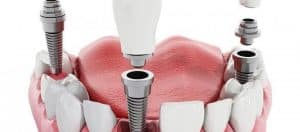Having a dental filling come loose or fall out can catch you off guard, whether it occurs during brushing or eating. While this event isn’t rare, your response is crucial. Immediate pain may not always be present, but prompt action to repair the filling is vital. Dental fillings are important for maintaining tooth strength and preventing further issues, underscoring the importance of quick repairs when they become damaged.
When considering the prevalence of dental fillings, it’s notable that three-quarters (77.4%) of Australians have at least one filling, underscoring the widespread occurrence of dental fillings and highlights the commonality of this dental issue among the population.
Importance of Addressing a Lost Dental Filling Promptly
Addressing a lost dental filling promptly is incredibly important for several reasons. Firstly, a lost filling exposes the vulnerable interior of the tooth to bacteria and debris. The tooth becomes susceptible to decay and further damage without the protective barrier the filling provides. This can lead to more extensive dental work being required in the future, potentially including procedures such as root canals or tooth extractions.
Secondly, ignoring a lost dental filling can increase sensitivity and discomfort. Exposed tooth tissue may be more sensitive to temperature changes, sweet or acidic foods, and pressure from chewing. This can cause discomfort or pain, making eating, drinking, or speaking difficult.
Also, leaving a lost filling untreated can compromise the tooth’s structural integrity. Over time, the tooth may weaken and become more prone to fractures or breakage. This not only affects the functionality of the tooth but can also impact the overall alignment and health of the surrounding teeth.
Addressing a lost dental filling promptly can help prevent complications that may arise from untreated dental issues. For example, decay that develops beneath the tooth’s surface can progress to infect the dental pulp, leading to abscesses and severe pain. These complications can be avoided by seeking timely treatment, saving both time and money in the long run.
Why a Filling May Come Loose
There are several reasons why a filling might become loose and eventually fall out, many of which are related to dietary habits and the mechanics of chewing.
A filling may fall out due to:
- New decay forms around the filling, weakening its bond with the tooth.
- Chewing with excessive force or pressure can gradually dislodge the filling.
- Biting into very hard or crunchy foods can cause the filling to become dislodged.
- Habitual teeth grinding, known as bruxism, can stress the filling and loosen it over time.
- Recent trauma to the tooth or its root, such as an injury or impact, can disrupt the filling.
- Chemical reactions that weaken the bond between the filling and the tooth, leading to its loosening and eventual loss.
Is Emergency Dental Care Needed for a Lost Filling?
A fallen-out filling typically isn’t considered a dental emergency. While it can be uncomfortable and worrying, it doesn’t usually require immediate treatment. However, if you’re experiencing severe pain or notice bleeding and inflammation around the gums, it may warrant emergency dental care. You can usually wait up to three days before seeking treatment. It’s essential to monitor symptoms closely and contact your dentist if you have concerns or if the pain worsens.
Signs Your Dental Filling Has Fallen Out
Recognising when a dental filling has fallen out is essential for timely intervention. Here are some common signs that indicate a lost filling:
Sudden Pain or Sensitivity
If you experience sudden pain or increased sensitivity in a tooth that previously had a filling, it could indicate that it has fallen out or become loose. This discomfort may occur while eating, drinking, or not using that tooth.
Feeling a Hole in the Tooth
Another telltale sign of a lost filling is the sensation of a hole or gap in the affected tooth. You may notice this while running your tongue over the tooth or biting down on food. The absence of the filling can create an unusual texture or sensation that wasn’t there before.
Visible Absence of Filling Material
In some cases, you may be able to visually inspect the tooth and see the missing filling material. This is more apparent if the filling was a large amalgam or composite filling. You might notice a space where the filling used to be, or you may see fragments of the filling material in your mouth.
Discolouration or Dark Spots
If the filling fell out due to decay or damage to the tooth, you may notice discolouration or dark spots on the affected tooth. This can indicate that the tooth structure has been compromised and may require immediate attention from a dentist.
Immediate Steps to Take
When your dental filling dislodges, acting swiftly to prevent potential complications is essential. Here’s what you should do:
Contact Your Dentist
If a dental filling comes loose or falling out, Contact your dentist as soon as possible to arrange an appointment. Inform them about the lost filling and any accompanying symptoms you may be experiencing. Timely professional attention is crucial for effective resolution.
Rinse Your Mouth
Use warm water to rinse your mouth thoroughly, removing debris or food particles from the exposed area. This simple step helps maintain oral cleanliness and minimises the risk of infection.
Apply Dental Wax or Temporary Filling Material
If you have dental wax or temporary filling material on hand, use it to temporarily cover the exposed portion of the tooth. This protective barrier shields the tooth from sensitivity and prevents harmful bacteria from entering the cavity. Follow the product instructions carefully for proper application.
Avoid Chewing on the Affected Side
To prevent further discomfort or damage, refrain from chewing on the side of your mouth where the filling came out. Choose soft or liquid foods that require minimal chewing until you can visit your dentist for repair.
How To Prevent a Filling from Coming Loose
Sticking to good oral care habits and watch your actions to keep your fillings secure. Start with a routine: brush your teeth twice daily with fluoride toothpaste and use floss to clean between them. Plaque buildup can weaken fillings, so staying on top is critical. Also, be careful when you eat. Avoid biting down too hard or chewing on tough objects, which can loosen your fillings.
If you grind your teeth at night, consider wearing a mouthguard to protect your dental work. Don’t forget to visit your dentist regularly for check-ups. They can catch any issues early on and fix them before they worsen. With these simple steps, you can keep your fillings secure and avoid needing replacements.
Contact Dentist Port Melbourne for Replacing Dental Filling
Contact Dentist Port Melbourne today to arrange your dental filling repair. Don’t let a loose or absent filling lead to discomfort or additional dental problems. Our team is ready to assist in restoring your smile and maintaining your oral health. Please schedule your appointment now to benefit from our expert dental filling repair services.












